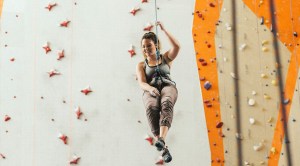Indoor climbing is no longer the fringe sport it once was. These days, climbing walls can be seen in numerous gyms across America as word spreads about the exhilarating, full-body workout (and fun) the sport provides.
What may seem like a playground for adults, indoor rock climbing offers mental and physical training that will strengthen your mind and body while satisfying your inner adventurer.
Climbing is a very mind-body sport. You are solving a puzzle while actively climbing a steep, vertical wall. Mentally; you’re reading the holds, or handles on the climbing wall, figuring out how to physically get to the top, explains Sasha DiGiulian, known as the world’s most decorated female climber, philanthropist, entrepreneur and author of Take The Lead: Hanging Keeping going, letting go and conquering life’s toughest climbs
So physically, you’re leveraging your body weight on the tips of your toes and feet (in climbing shoes) as contact points on the wall, she says. This is where mental training meets physical.
Climbing requires strong shoulders and arms, but also a lot of core, as this is the connection between the upper and lower body; to create balance and stability, as well as leg strength to push up, says DiGiulian. And with that, indoor climbing will help you develop a strong and toned body.
DiGiulian, the first North American woman to climb grade 9a, 5.14d, recognized as one of the hardest sport climbs achieved by a woman, shares her top tips for an ascending indoor climbing experience.
Must have indoor climbing equipment
Most gyms have rental equipment that allows you to see if climbing is something you want to invest in without having to purchase the equipment in advance.
- To enjoy
- Climbing shoes
- Chalk bag
- Safety device
- String
If you’re climbing alone or bouldering (which means no ropes), all you need are climbing shoes and a bag of chalk.
Step-by-step instructions for your first indoor climbing experience
Climbing Tips for Beginners:
- Start on a slab or less than a vertical wall to understand the basic movement of the sport before diving into a steeper wall angle.
- Focus on your hands and feet.
- Try to relax your shoulders and keep your heels down.
- Hiring an instructor when starting out will help you learn climbing terminology such as tie-ins, allowing you to understand how to use the equipment correctly.
Step by step Climbing Tips
- Put on your harness This is your safety belt that will connect you to the rope and the wall. If you fall, the rope will catch you through the center loop of the harness.
- Then place a bag of chalk. This is a small bag that you wear around your waist when your hands sweat, to help absorb the sweat and help with friction against the wall.
- Tie off the rope and have your belayer secure you at the other end (assuming you are top roping) with a belay device called a Petzl GriGri.
- Next, put on your climbing shoes (pro tip: do this after lacing up), DiGiulian likes to put on her climbing shoes after lacing up to save time putting on her shoes since she wears them two sizes smaller than her regular shoes. for hypersensitivity and control in your toe box.
- Now that you and your belayer are secured in your respective harnesses and tied to the rope (using a figure eight knot), approach the start of the climb.
Good to know:
- When climbing, you will focus on generating movement from the hips. Use the front box of the shoe, where your big toe is essentially, to guide your placement on the climbing holds.
- Try not to be a starfish, that is, lead with your hands but also move your feet up as you go.
- Do one movement at a time and when your hands get sweaty, apply chalk.
Tips for staying safe while climbing:
Indoor climbing is very safe, however, DiGiulian reminds you to make sure your rope is tied properly to the harness and that your belayer is secured with a belay device that he or she also knows how to use.
Remember to have fun and climb with a friend. The professional climber explains that progress in your climbing ability comes with time and consistency. It would be best to start climbing to develop a pattern of going to the gym. The further you go, the better you’ll get, but also don’t overdo it too quickly, because your muscles, tendons and ligaments may require a moment to adapt to the sport. Expect pain in your forearms after your first climb. But also expect the beginning of a new adventure addiction!
#Ultimate #Guide #Indoor #Climbing #Beginners #Muscle #Fitness
Image Source : www.muscleandfitness.com


